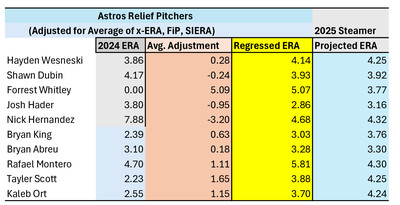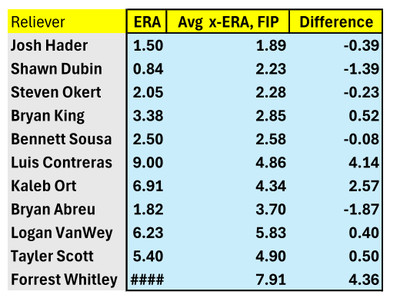
Looking at previous and future regression in the bullpen.
After the Astros’ bullpen imploded twice in the Rays’ series at Daikin Park, you can be excused if you are wary when the Astros relief corps enters the game in the near future. There is a reason that Rolaids sponsored the reliever awards—you might reach for your antacids when a reliever not named Hader enters the game. The Astros were a league leading bullpen going into the series, but the bullpen blew up two games that were knotted at a 3-3 score.
During that four game period which comprised the home series with the Rays:
- the Astros’ bullpen gave up 23 runs, the most for any bullpen over the four day period. (The second most bullpen allowed runs over that period was by the Seattle Mariners with 18 RA.)
- The Astros bullpen, not surprisingly, had the worst ERA over that period, 16.78. (The Yankees had the second worst ERA over that period, 10.66.)
- The only three relievers who did not give up a run were the high leverage guys, Abreu and Hader, and the position player pitcher, Salazar.
Regression Analysis Preseason
On January 28, before the season began, I wrote an article about the potential for regression from relievers 2024 runs allowed. Basically the point of the evaluation is to identify relief pitchers who over-performed their underlying peripheral stats, like x-ERA and FIP, over the course of 2024. This is the table from that analysis of 2024 (note that positive adjustment means likely regression higher and negative means vice versa):

Data from Fangraphs
As I stated in that article: Three relievers (King, Scott, and Ort) who provided surprisingly good results in 2024 were a bit lucky and are likely to regress significantly in 2025. King is still projected to provide a useful 3.76 ERA, but Scott and Ort are candidates to regress harder. Both are projected to provided ERAs of 4.25 and 4.24, respectively. Given the importance of their role in 2024, regression of that magnitude in 2025 could be a problematic development for the bullpen.
The two relievers with very large indicators of over-performance in 2024, Taylor Scott and Rafael Montero, are no longer with the team. Montero was traded to the Braves early in the 2025 season. Scott tried to reprise his previous bullpen role during the first month of the 2025 season, but he was DFA’d after poor performance and the numbers game squeezed him off the roster. He is now a free agent.
Note that the analysis expected Josh Hader to revert in the direction of improved ERA performance. And, in fact, Hader, through the first third of the season, has been one of the best closers in baseball.
Current Potential for Regression
That article was based on under/over performance in 2024. Turnning to 2025 almost all of the relievers had very good ERAs going into the Rays series. But where does their current 2025 ERA reflect warning signs of regression? Negative differences are indicators of over-performance and vice versa for positive differences.

Source: Fangraphs Data
The theory behind this exercise is that the comparison to FIP and x-ERA may tell us about the risk that relievers’ 2025 current ERA might move in the direction of a higher ERA. Generally speaking, I don’t put much stock in relatively small differences (less than 0.5) because it’s not like these are precise projections.
The only relievers with regression warning signs in the Taylor Scott / Rafael Montero range from the previous analysis are Bryan Abreu and Shawn Dubon. Abreu’s differential is partly due to a very low current ERA compared to a much worse x-ERA (4.59), perhaps indicating he has gotten lucky in terms of the defense behind him. Despite that fact, Abreu’s FIP (2.80) is still quite good, although it is higher than his current 1.82 ERA. I’m not overly worried about Abreu, but it’s worth keeping an eye on. It would not be a surprise if Abreu’s ERA trends upward, but hopefully it wouldn’t be a rocky trend.
Dubin has an extremely low ERA and his x-ERA/FIP mean is still pretty good, 2.23. He has only pitched 10 innings, and his effectively wild pitching style seems like it could be volatile.
Setting aside the low leverage pitcher Whitley, Ort and King got beat up the most in the Rays’ series. Both pitchers now have an ERA higher than their mean x-ERA/FIP. The difference is that King’s mean for the peripherals is more reasonable than Ort’s. King is at a good 2.85 mark and Ort is at an uglier 4.34 mark. Both relievers may trend in an improved ERA direction, but King’s current ERA is 3.38 vs. Ort at 6.91. I don’t think we should worry about King, and Ort probably should see more low leverage situations until he proves otherwise.
Hader, Okert, and Sousa all have a current good ERA in the 1.50 – 2.50 range and their mean peripheral measures indicate that they mostly deserve good numbers. That is because Hader, Okert and Sousa should have 1.89, 2.28, and 2.58 ERAs, respectively. All three have been legitimately good so far. Sure, it’s unlikely Hader goes through the season without blowing a save, but I don’t see any blinking warning signs.
I feel like it’s hard to evaluate Whitley, other than to point out that his numbers are really bad, but perhaps not quite as bad as the 12+ ERA indicates. The Astros risk losing Whitley if he is demoted or DFA’d. But at some point the Astros may have to make some decisions about what to do with the former top prospect. Right now, he will work low leverage situations, but the Astros may face a time when they can’t keep too many low leverage relievers on the active roster.
I will make one final check up on the bullpen’s effectiveness during the Rays’ series. Stuff+ might give us some data on what caused the blow up. The Astros’ relievers stuff was still pretty good in that series. The reliever Stuff+ over those four days was above average (104). But the reliever Location+ was only 85, ranking 27th among bullpens over that interval. The Astros’ bullpen Location+ for all of 2025 was 96. (By the way, catcher turned pitcher Salazar’s Stuff+ was 29—one of the lowest scores I’ve seen—but who cares?)
The blow ups primarily were caused by lapses in control and command, based on the poor Location+ result. Poor pitch location can be aberrant sometimes. And when it occurs, it depends on whether the other team can take advantage. The Rays’ hitters did.
Personally, I find these results to be somewhat reassuring, as in—no, the bullpen isn’t falling apart.